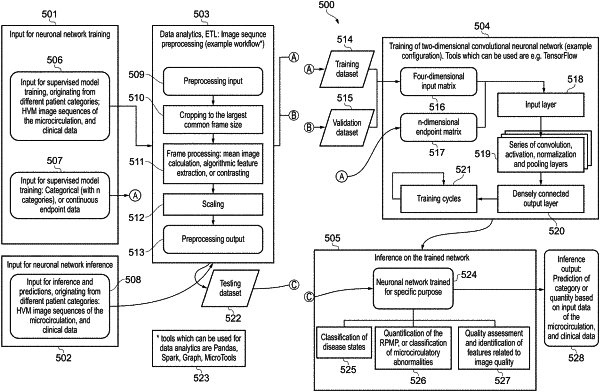| CPC G02B 21/36 (2013.01) [G02B 21/0012 (2013.01); G06N 3/063 (2013.01); G06N 3/08 (2013.01); G06T 7/0012 (2013.01); G16H 50/20 (2018.01); G06T 2207/10016 (2013.01); G06T 2207/10056 (2013.01)] | 21 Claims |

|
1. An intelligent vital microscopy, IVM, device comprising:
a magnifying lens operably coupled to a focus mechanism and an illumination source for illuminating an organ surface;
a receiver operably coupled to the magnifying lens focus mechanism and illumination source and configured to receive at least one IVM image of a human microcirculation, MC, of the organ surface;
a learning processor coupled to the receiver and configured to:
process the at least one IVM image, identify single cellular oxygen transporting constituents of the MC embedded within flowing red blood cells, RBCs, of the at least one IVM image and extract at least one MC variable that describes oxygen transportation by RBCs in the MC, and
identify from the extracted at least one MC variable that describes oxygen transportation by RBCs of the processed at least one IVM image, based on MC analysis of training data images previously input to the learning processor for analyzing oxygen transportation by RBCs in the MC, a disease diagnosis and identify an amount of therapy arranged to provide a therapeutic effect to the human of the at least one IVM image in response to the identified disease diagnosis; and perform at least one of:
identify hypovolemia, hypotension, overhydration and dehydration and a need for a therapeutic treatment that improves the transportation of oxygen in the human by at least one of: fill intravascular volume of the MC; provide hydration, provide blood transfusion, increase of cardiac output; increase perfusion pressure; start diuretic therapy or haemodialysis, halt haemodialysis, administration of vasopressure or vasodilatory agents;
identify when a treatment dose threshold is reached in tumour therapy in advance of an occurrence of complications;
identify when haemodialysis or continuous renal replacement therapy is recommended and output a clinical decision regarding duration and a need for supplemental therapy;
identify a need for blood purification;
identify during a blood purification process, a time for cessation of the blood purification process or a need to adjust at least one parameter of the blood purification process;
output an identification of whether an intended therapeutic intervention will provide a positive result;
provide feedback as to an efficacy of an intended therapeutic intervention once applied and identify an alternative dose adjustment if the efficacy is not as desired;
identify a diagnosis of at least one of: radiotherapy photodynamic chemotherapy surgery, and
an output coupled to the learning processor and configured to output a clinical decision regarding a need for adjuvant therapy.
|